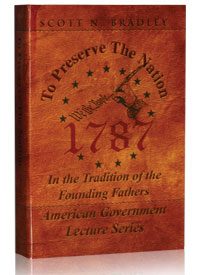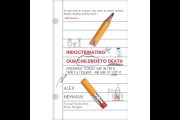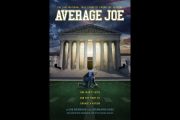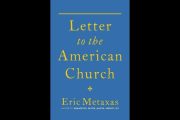
In a day when the limited constitutional government our Founders bequeathed to us has been disfigured almost beyond recognition, when the principles of liberty that animated our forefathers have been abandoned by a large segment of our citizenry, when our own history and that of other civilizations is forgotten by most, and when the system of morals that gave rise to American civilization has been all but abandoned, the need for ringing reminders of our true heritage has never been more acute.
Scott Bradley’s lecture series (book and DVD set) To Preserve the Nation: In the Tradition of the Founding Fathers is such a reminder. Bradley’s materials offer a sweeping portrayal of American history combined with a systematic, readable treatment of the ageless principles of liberty. Bradley, a prominent constitutional scholar, educator, and sometime political candidate, has produced a work in the worthy tradition of Bastiat, Garrett, Flynn, Hazlitt, and other teachers of liberty.
Covering Common Ground
Early chapters of To Preserve the Nation emphasize general principles — “America’s Spiritual Foundation,” “Individual Liberties and the American Government,” and “American Principles of Federalism” — as well as a broad historical overview — “Outline of American History Time Line” — while later chapters deal in specific issues and topics ranging from education to Washington’s Farewell Address.
To Preserve the Nation is structured to accommodate classroom or home study, with each chapter offering a list of references for further reading for the serious student, an explanatory essay, and pages of illuminating quotes to buttress the main points. Chapter 10, for example, “The Right to Keep and Bear Arms,” provides both a history of this crucial right and an explanation of why early Americans (and a few enlightened Europeans, such as Italian legal scholar Cesare Beccaria) considered the individual right to keep and bear arms so essential. According to Bradley, the Anglo-American tradition (now, alas, almost entirely abandoned by England with its Draconian modern gun-control laws) of private weapons ownership can be traced at least as far back as the English monarch and unifier of Anglo-Saxon England Alfred the Great. In those surprisingly enlightened times so often dismissed as the undifferentiated “Dark Ages,” all Englishmen were required to be armed and to be willing to take up arms in defense of their country (the institution of “weapontake”). From Bradley we also learn that colonial Virginia and Massachusetts both passed laws requiring men to be armed, with the former adding a statute requiring arms to be brought to Sunday church services and the latter fining anyone refusing to arm himself.
On the other hand, the more modern legislative trend has been to disarm law-abiding citizens, as embodied by the 1934 National Firearms Act — the first national gun-control legislation, which established federal controls on the sale of fully automatic machine guns, “sawed-off” shotguns, and other weapons that had gained notoriety as a consequence of the wave of violent crime that coincided with the Prohibition era — and the 1939 Supreme Court case United States v. Miller, in which the Supreme Court upheld limits enacted by the federal government on the use and possession of sawed-off shotguns.
While To Preserve the Nation does not delve too deeply into economics, Chapter Eight, “Of Money and Economics,” provides essential material on one of the issues most central to liberty yet withal among the least understood, the origin and nature of money. Here are to be found the perspectives of several of the Founding Fathers on what ought to constitute sound money. President Washington, in a letter to a friend, observed:
Experience has demonstrated the impracticality long to maintain a paper credit without funds for its redemption. The long depreciation of our currency [during the War of Independence] was in the main a necessary effect of the want of those funds.
And Thomas Jefferson was keenly aware of the importance of maintaining a precious metal (“specie”) basis for currency:
Specie is the most perfect medium, because it will preserve its own level; because, having intrinsic and universal value, it can never die in our hands; and it is the surest resource of reliance in time of war…. The trifling economy of paper as a cheaper medium, or its convenience for transmission, weighs nothing in opposition to the advantages of the precious metals…. [Paper money] is liable to be abused, has been, is, and forever will be abused, in every country in which it is permitted.
In stark contrast with the simple, commonsense views of the Founders, Depression-Era Federal Reserve Chairman Marriner Eccles’s glib sophistries about fiat money and its relationship with government debt, given in congressional testimony, ring hollow and ineffectual indeed:
In purchasing offerings of Government bonds, the banking system as a whole creates new money, or bank deposits. When the banks buy a billion dollars of government bonds as they are offered — and you have to consider the banking system as a whole as a unit — the banks credit the deposit account of the Treasury with a billion dollars…. They actually create, by a bookkeeping entry, a billion dollars.
Simply put, the Founders believed in limiting the monetary power of the state by insisting on a precious metal standard to prevent government from printing money at whim to pay for politicians’ grand schemes. In our day, however, the false gospel of fiat currency — money whose supply can be increased by the printing press or the computer entry, and whose value is steadily degraded by inevitable inflation — is almost universally accepted, giving the federal government the power to print money it cannot lay its hands on by more honest means (i.e., direct taxation). Bradley observes:
It is tragic how the nation for many decades has strayed from the sound financial principles of those who founded this great nation! The effect of these modifications upon the nation’s financial well-being has been profound. Since these changes have been implemented … the national debt has blossomed astronomically, and the money created by this polluted system has caused the purchasing power of the United States dollar to plummet.
An Uncommon Result
One of Bradley’s most insightful and unexpected chapters is Chapter 14, “All Revolutions Are Not Created Equal (The American Revolution vs. Subsequent Revolutions).” This, a topic not often given due consideration in modern schools and universities, is indispensable for the student of liberty since, as Bradley points out, “the American founders have virtually nothing in common with the revolutionaries [of France and other countries].” Mere revolts against established orders are not necessarily popular, nor do they always lead to limited government. In point of fact, the vast majority of so-styled “popular uprisings” throughout history have produced greater tyranny in their wake. From the “Nika uprising” against the late Roman tyrant Justinian to the various peasant uprisings in the Middle Ages to the French and Russian revolutions of the modern era, revolts on behalf of the “huddled masses” have either strengthened the hand of the oppressive regime or cleared the way for even more repressive successors. There have been a few exceptions, of course — the Roman revolt against the Tarquins that created the Roman Republic, England’s bloodless Glorious Revolution, and, of course, the American Revolution, perhaps better denominated the War of Independence. But for the most part, revolution has been synonymous with oppression, the professed aims of revolutionary instigators notwithstanding.
This is because, more often than not, “popular” revolutions are clever contrivances of conspiratorial elites, and their aim is to replace unpopular monarchy or autocracy with utopian totalitarianism. Such were the motives behind the French revolutionaries, among whom Illuminist and Jacobin conspirators, with their deadly utopian designs, figured prominently. So also with the Russian Bolsheviks, who gave the unhappy Russians, and many other nationalities across the sprawling empire of the czars, a tyranny far worse than the autocratic incompetence of Nicholas II. Such revolutionaries always profess to embrace “democracy,” which, as Bradley points out, is little more than mob rule in politically-correct guise — in opposition to republican government, where popular whims are held in check by laws protecting with impartiality the rights of everyone, which is what the American Founders espoused.
Besides its 17 chapters, To Preserve the Nation also contains 11 appendices, including the complete text of the Mayflower Compact and the Constitution, and biographical sketches of Locke, Montesquieu, Blackstone, and St. George Tucker. For those preferring the spoken word, the entire work is also available in lecture format on DVDs, CDs, and MP3s at www.ToPreserveTheNation.com.
For anyone desiring to improve their own or their children’s understanding of our great heritage, To Preserve the Nation is a very fine start.
To Preserve the Nation: In the Tradition of the Founding Fathers, by Scott Bradley, published 2009, hardbound, 526 pages. (Hardbound and paperbound editions of the book, as well as DVD, CD, and MP3 lecture formats, are available at www.ToPreserveTheNation.com.)



